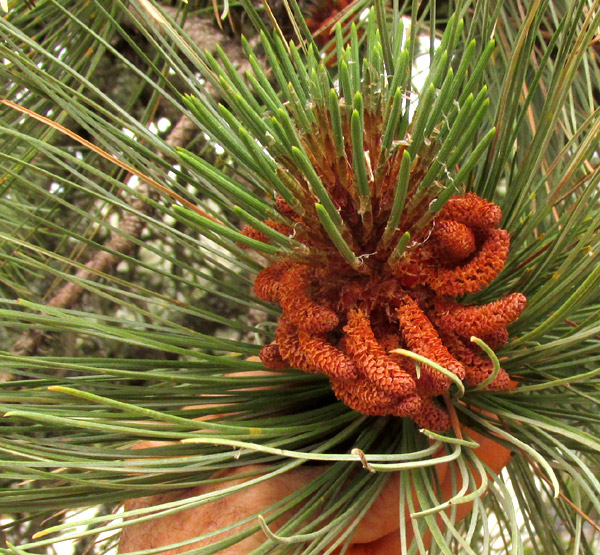Excerpts from Jim Conrad's
Naturalist Newsletter
entry from field notes dated May 4, 2023, taken about 150m uphill on NE-facing slope, above intersection of road from Hwy 120 to San Joaquín, with road to El Doctor; juniper and pine forest on limestone bedrock; elevation ±2425m (7950 ft); Eastern Sierra Madre mountains of east-central Querétaro state, MÉXICO, (N20.88°, W99.62°)
SMOOTH-BARK MEXICAN PINE
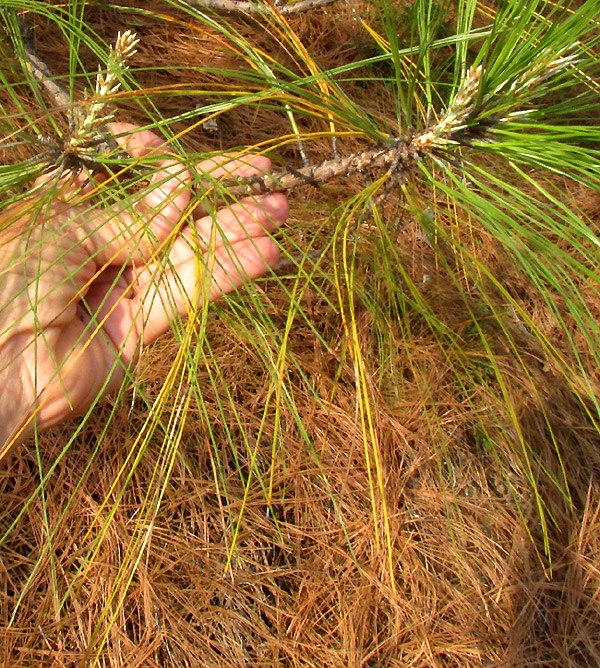
The above pine branch with long, somewhat drooping needles gave a first impression of being a Mexican Weeping Pine, which we've seen in this general area. However, I remembered that pine's needles seeming to "weep" more decisively. Cones hanging on the tree had their scales wide open, having already released their seeds, so it was hard to say what the unopen shape had been:

A broken-off cone bore a short stalk:
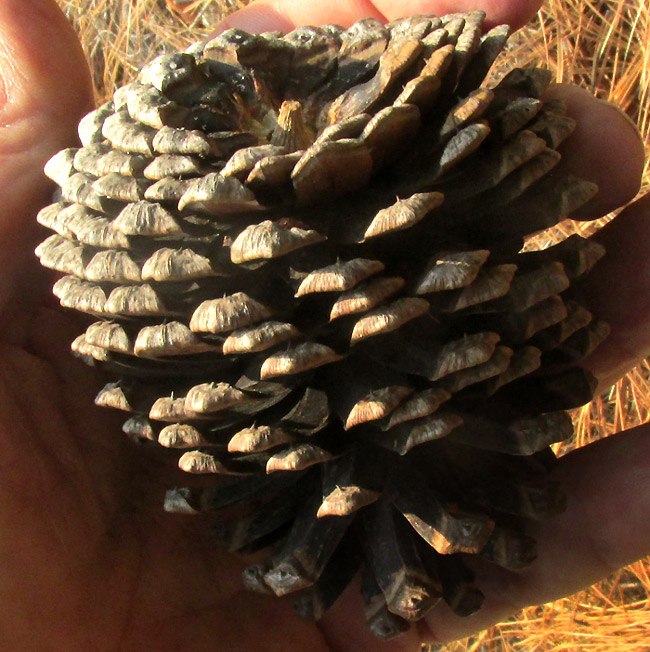
The cone was about 8cm long (3in). Also, note the little prickle atop each scale, growing from the scale's top surface, not the tip. In certain species it's at the tip.

Five needles were produced in all the leaf groupings I checked. This was a decisive difference from the Mexican Weeping Pine, for that species' fascicles mainly developed only 3, 4 or thereabouts, only occasionally 5.
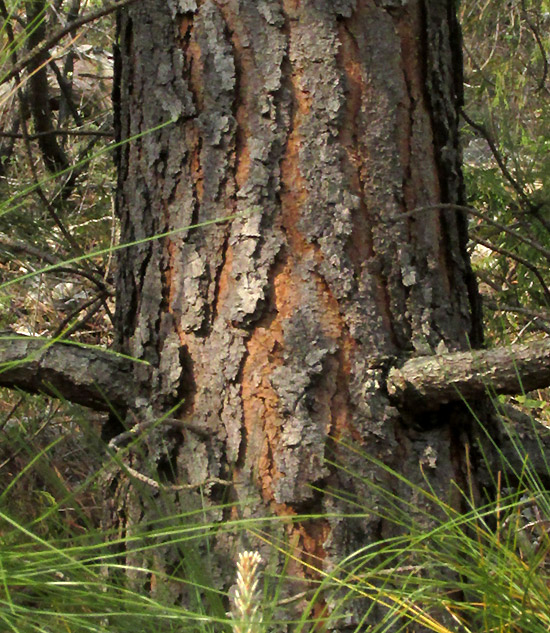
The tree's trunk bore ridges of rough bark separated by narrow, flat-bottomed furrows.
There's no taxonomic treatment for the pines of this part of upland central Mexico, but at this time it seems that in this area if you have a pine consistently with 5 needles per fascicle, and the slender, flexible leaves are up to about 25cm long (10in), then you have PINUS PSEUDOSTROBUS, sometimes in English known as the Smooth-bark Mexican Pine.
Pinus pseudostrobus occurs spottily in uplands from northern Mexico south to Honduras and El Salvador. I'm unsure why it has an English name; probably because pines in general are of commercial interest throughout much of the world and this species is heavily harvested in Mexico, its wood being used in construction and other uses. It's considered one of Mexico's most common and useful pines. I'm also unsure why it's called Smooth-bark, since our tree's trunk is anything but smooth. In Spanish it's sometimes called pino liso, or "Smooth Pine." Maybe it's because the bark of young trees is fairly smooth. The species name pseudostrobus also raises questions. Pinus strobus is a common and important pine in northeastern North America, but it's very unlike this species, and there's little about our pine that "pseudo" the northern species.
With Pinus pseudostrobus, that's just the beginning of the questions. Conifers.org's Gymnosperm Database Pinus pseudostrobus page outlines the situation by first reminding us that Mexico is the world center of pine species diversity, and that Mexico appears to be one of the few remaining places where new conifer species are actively arising. That being said, the taxonomic state of Pinus pseudostrobus is so unclear that the name "... is little more than a tag for a large and diverse collection of populations that are distinguishable from other, closely related taxa on the basis of (relatively) easily observed characters." Also it hybridizes with some other pines.
In Mexico, not only is Pinus pseudostrobus wood used for construction, but also for pulp and resin production. In the uplands of southern Mexico, Guatemala and parts of Honduras, it's one of the most commonly harvested timber trees. Over large areas the best stands have been depleted, though the species isn't yet considered endangered.
As with most pines, when you're sinuses and lungs are congested with a cold, you can boil this pine's needles to make a tea, of which the taste and vapors seem to help.
Entry from field notes dated June 29, 2023, taken on valley slope forested with oaks and pines along road between Puerto del Zenthé and Chavarrías. That narrow road is attained by taking the very narrow, zigzagging road up the ridge rising on the southwestern side of Curva de la Doctorcilla, which is near km 18 on the branch road beginning at El Campamento and continuing to El Doctor, and which is numbered Hwy 120, though it branches off the main Hwy 120 running between San Juan del Río and Jalpan; at the road juncture atop the ridge, go south; limestone bedrock; elevation ~2400m (~7900 ft), Querétaro, MÉXICO, (N20.84890°, W99.60416°)
CONE RUST ON PINUS PSEUDOSTROBUS
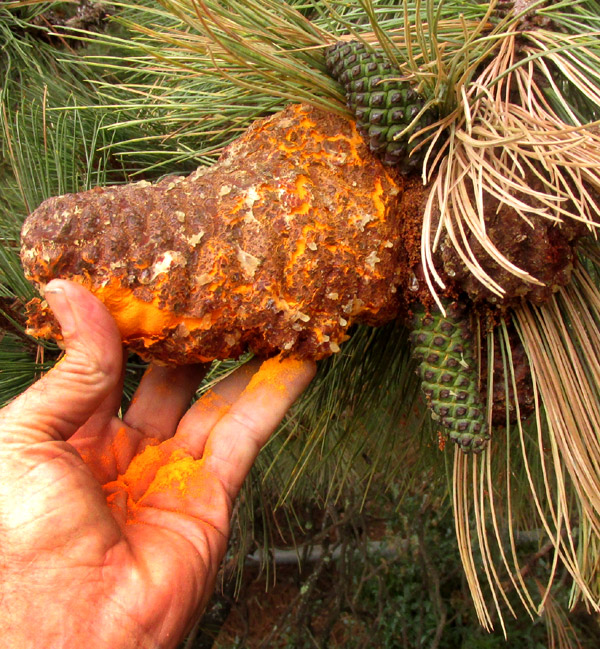
Beside the road skirting the tiny community hosting a community kindergarten on the above-mentioned road, a relatively large Pinus pseudostrobus bore numerous cones infected with the fungal rust disease shown above. The infected, spore-producing, or sporulating, cone was much larger than uninfected mature cones. When cones are in this oversized, sporulating state, they're referred to as galls, and produce no seeds; the fungus takes over the cone and produces only spores. Note the orange spores on my hand. Two smaller, green, immature cones beside the gall stage appear uninfected, while a fourth cone, opposite the big one, seems to display an earlier stage of infection. Here's what other stages of the infection looks like:

The cone on the left was melting away, and disintegrated when touched.
This fungal rust disease is produced by Cone Rust, Cronartium conigenum, details of which are described at the link.
The big pine was producing male pollen cones, not seen earlier. Here's what they looked like:
